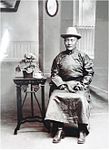ᱢᱳᱝᱜᱳᱞ
Монголчууд Mongolchuud ᠮᠣᠩᠭᠣᠯᠴᠤᠳ | |
|---|---|
 A Mongolian Buddhist Monk | |
| ᱜᱩᱴ ᱦᱚᱲ ᱮᱞ | |
| ᱜᱚᱴᱟᱜᱩᱴᱤ 10–11 million (2016) | |
| ᱰᱷᱮᱨ ᱧᱚᱜ ᱦᱚᱲ ᱮᱞ ᱢᱮᱱᱟᱜ ᱠᱚ ᱴᱚᱴᱷᱟ | |
| 6,146,730 (2015)[᱑] | |
| ᱪᱷᱟᱸᱪ:Country data Mongolia | 3,201,377[᱒] |
| 822,763[᱓] | |
| 41,500[᱔] | |
| 18,000–20,500[᱕] | |
| ᱪᱷᱟᱸᱪ:Country data Czech Republic | 10,200[᱖] |
| ᱪᱷᱟᱸᱪ:Country data Kyrgyzstan | 10,000[᱗] |
| 7,340[᱘] | |
| 6,311[᱙] | |
| 4,056 | |
| 3,331 | |
| 2,723 | |
| 2,459 | |
| ᱪᱷᱟᱸᱪ:Country data Turkey | 2,143 |
| ᱪᱷᱟᱸᱪ:Country data Austria | 2,007[᱑᱐] |
| 1,530 | |
| ᱯᱟᱹᱨᱥᱤ ᱠᱚ | |
| Mongolian language | |
| ᱫᱷᱚᱨᱚᱢ | |
| Predominantly Tibetan Buddhism, background of shamanism.[᱑᱑][᱑᱒][᱑᱓] minority Tengrism or Folk religion, Sunni Islam, Eastern Orthodox Church, Taoism, Bön and Protestantism. | |
| ᱥᱩᱯᱩᱨ ᱥᱟᱹᱜᱟᱹᱭᱟᱱ ᱡᱟᱹᱛ ᱠᱚ | |
| Proto-Mongols, Khitan people | |
The Mongols (Mongolian: Монголчууд, ᠮᠣᠩᠭᠣᠯᠴᠤᠳ, Mongolchuud, ᱪᱷᱟᱸᱪ:IPA-mn) are an East Asian ethnic group native to Mongolia and to China's Inner Mongolia Autonomous Region. They also live as minorities in other regions of China (e.g. Xinjiang), as well as in Russia. Mongolian people belonging to the Buryat and Kalmyk subgroups live predominantly in the Russian federal subjects of Buryatia and Kalmykia.
The Mongols are bound together by a common heritage and ethnic identity. Their indigenous dialects are collectively known as the Mongolian language. The ancestors of the modern-day Mongols are referred to as Proto-Mongols.
Definition
[ᱥᱟᱯᱲᱟᱣ | ᱯᱷᱮᱰᱟᱛ ᱥᱟᱯᱲᱟᱣ]Broadly defined, the term includes the Mongols proper (also known as the Khalkha Mongols), Buryats, Oirats, the Kalmyk people and the Southern Mongols. The latter comprises the Abaga Mongols, Abaganar, Aohans, Baarins, Gorlos Mongols, Jalaids, Jaruud, Khishigten, Khuuchid, Muumyangan and Onnigud.
The designation "Mongol" briefly appeared in 8th century records of Tang China to describe a tribe of Shiwei. It resurfaced in the late 11th century during the Khitan-ruled Liao dynasty. After the fall of the Liao in 1125, the Khamag Mongols became a leading tribe on the Mongolian Plateau. However, their wars with the Jurchen-ruled Jin dynasty and the Tatar confederation had weakened them.
In the thirteenth century, the word Mongol grew into an umbrella term for a large group of Mongolic-speaking tribes united under the rule of Genghis Khan.[᱑᱔]
Gallery
[ᱥᱟᱯᱲᱟᱣ | ᱯᱷᱮᱰᱟᱛ ᱥᱟᱯᱲᱟᱣ]-
Mongol Empress Zayaat (Jiyatu), wife of Kulug Khan (1281–1311)
-
Genghis' son Tolui with Queen Sorgaqtani
-
13th century Ilkhanid Mongol archer
-
Mongol soldiers by Rashid al-Din in 1305
-
Kalmyk Mongol girl Annushka (painted in 1767)
-
A 20th-century Mongol Khan, Navaanneren
-
The 4th Dalai Lama Yonten Gyatso
-
Mongol women archers during Naadam festival
-
A Mongol musician
-
A Mongol Wrangler
-
Buryat Mongol shaman
-
Kalmyks, 19th century
-
Mongol girl performing Bayad dance
-
Buryat Mongols (painted in 1840)
-
Buryat Mongol boy during shamanic rite
-
Concubine Wenxiu was Puyi's consort
See also
[ᱥᱟᱯᱲᱟᱣ | ᱯᱷᱮᱰᱟᱛ ᱥᱟᱯᱲᱟᱣ]- Altan Telgey
- American Center for Mongolian Studies
- Horse culture in Mongolia
- List of medieval Mongol tribes and clans
- List of modern Mongolian clans
- List of Mongol states
- List of Mongolians
- Mongolian name
- Qaraunas
References
[ᱥᱟᱯᱲᱟᱣ | ᱯᱷᱮᱰᱟᱛ ᱥᱟᱯᱲᱟᱣ]- ↑ Demographics of China
- ↑ "Монголын үндэсний статистикийн хороо". National Statistical Office of Mongolia. Retrieved 2013-11-14.
- ↑ 2,656 Mongols proper, 461,389 Buryats, 183,372 Kalmyks (Russian Census (2010))
- ↑ "'Korean Dream' fills Korean classrooms in Mongolia", The Chosun Ilbo, 2008-04-24, archived from the original on September 23, 2008, retrieved 2009-02-06
- ↑ Bahrampour, Tara (2006-07-03). "Mongolians Meld Old, New In Making Arlington Home". The Washington Post. Retrieved 2007-09-05.
- ↑ "Archive copy". Archived from the original on 2023-03-05. Retrieved 2020-11-01.
{{cite web}}: CS1 maint: archived copy as title (link) - ↑ President of Mongoli Received the Kalmyk Citizens of the Kyrgyz. 2012 Archived ᱒᱐᱑᱖-᱑᱒-᱐᱖ at the Wayback Machine.
- ↑ "Mongolia National Census" (PDF) (in Mongolian). National Statistical Office of Mongolia. 2010. Archived from the original (PDF) on 15 September 2011. Retrieved 29 January 2017.
{{cite web}}: CS1 maint: unrecognized language (link) - ↑ NHS Profile, Canada, 2011
- ↑ "Bevölkerung nach Staatsangehörigkeit und Geburtsland" [Population by citizenship and country of birth] (in German). Statistik Austria. 3 July 2014. Retrieved 21 August 2014.
{{cite web}}: CS1 maint: unrecognized language (link) - ↑ National Bureau of Statistics of the People's Republic of China (April 2012). Tabulation of the 2010 Population Census of the People's Republic of China. China Statistics Press. ISBN 978-7-5037-6507-0. Retrieved 2013-02-19.
- ↑ China.org.cn – The Mongolian ethnic minority
- ↑ China.org.cn – The Mongolian Ethnic Group
- ↑ "Mongolia: Ethnography of Mongolia". Encyclopædia Britannica. Retrieved 2007-07-22.
External links
[ᱥᱟᱯᱲᱟᱣ | ᱯᱷᱮᱰᱟᱛ ᱥᱟᱯᱲᱟᱣ]- "Evidence that a West-East admixed population lived in the Tarim Basin as early as the early Bronze Age" Li et al. BMC Biology 2010, 8:15.
- Ethnic map of Mongolia
- Map share of ethnic by county of China
- CS1 maint: archived copy as title
- Webarchive template wayback links
- CS1 maint: unrecognized language
- Articles with short description
- Articles with long short description
- Short description is different from Wikidata
- Articles using infobox ethnic group with image parameters
- Articles containing Mongolian-language text
- Wikipedia articles with BNF identifiers
- Pages with red-linked authority control categories
- Wikipedia articles with LCCN identifiers
- Wikipedia articles with NDL identifiers
- Wikipedia articles with NKC identifiers
- Wikipedia articles with TDVİA identifiers
- Wikipedia articles with VIAF identifiers
- Wikipedia articles with WorldCat-VIAF identifiers
- Mongols
- Mongolia
- Mongol peoples
- History of Mongolia
- Modern nomads
- Nomadic groups in Eurasia




















